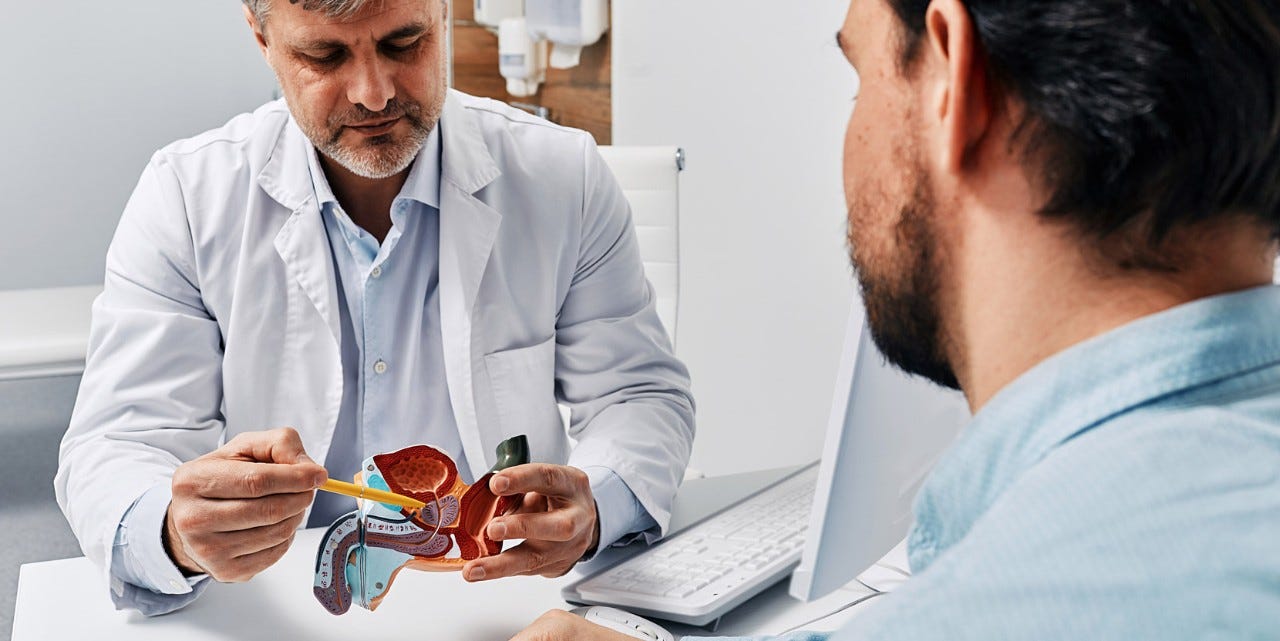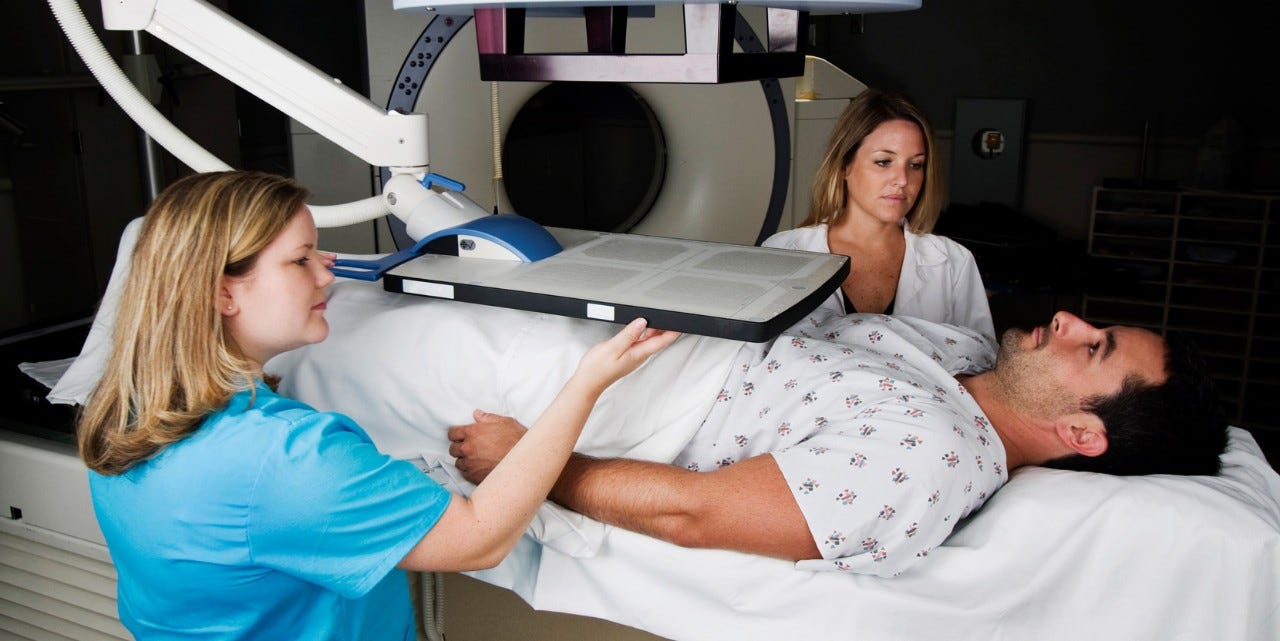Men’s health: getting to know your prostate
The prostate - also known as the prostate gland – usually gets bigger with age, which can lead to various complaints.

The prostate plays an important role in the male body. It is responsible, among other things, for the production of testosterone and is involved in sperm production, ejaculation and hormone metabolism. Despite its importance, the prostate gland is often only discussed when it has started to cause problems. For example, it can cause problems with urination in older men.
Anatomy of the prostate
The prostate is about 4 centimetres in size, walnut-shaped and consists of numerous glands, elastic connective tissue rich in blood vessels, and muscle fibres. The prostate gland is encased in a firm capsule of connective tissue. Positioned directly below the bladder, it surrounds the urethra in a ring shape. It borders the rectum at the back.
In a healthy 20-year-old man, the prostate weighs around 20 grams. During the course of his life, it can increase to over 100 grams. “In some cases, the prostate volume can increase up to 300 mm,” says Dr Daniel Engeler, chief consultant for Urology at the Cantonal Hospital of St. Gallen.
Role and function
The prostate is a sex gland and produces part of the man’s semen. “The milky, thin and slightly acidic prostate secretion contains trace elements and proteins that are important for sperm. The prostate is also important for male fertility,” says Daniel Engeler.
However, it only has an indirect effect on a man’s potency. The prostate converts testosterone, which is produced in the testicles, into its most biologically active form, di-hydro-testosterone (DHT). This in turn influences the function of the male sex organs, hair, muscle and bone growth, sexual development and the male sex drive.
Complaints and diseases
Very often patients don’t notice changes to their prostate. However, complaints and diseases can be divided into three main groups:
-
Inflammatory diseases (prostatitis)
Prostatitis is a painful swelling or inflammatory disease of the prostate. It is often caused by a bacterial infection. Men who cycle a lot can also develop prostatitis, with pain in the perineum, lower abdomen or lower back, penis or testicles. Other symptoms of an inflammatory disease of the prostate include pain while urinating, a frequent urge to urinate and a high temperature. In rare cases, it can even lead to blood poisoning.
-
Benign prostate enlargement (benign prostatic hyperplasia)
Almost all men are affected by prostatic hyperplasia as they get older. It is still not known exactly why the prostate gland gets bigger with age. “Medical science attributes it to the increased growth of hyperplastic tissue caused by hormonal changes as men age. For example, men who don’t produce sexual hormones because they’re missing testicles or suffer from a disease don’t suffer from an enlarged prostate.” Common symptoms of benign prostatic hyperplasia are:
- A weak urine stream
- An urgent need to urinate
- A stream that stops and starts
- Irritation symptoms such as frequent urination at night or a strong urge to urinate
- Not being able to fully empty the bladder
- Dribbling at the end of urination
-
Malignant change (prostate cancer)
Malignant changes to the prostate are usually asymptomatic, which is why it often takes a long time for a diagnosis to be made. That’s why Engeler encourages men to go for preventive check-ups. “This is the only way to detect prostate cancer at an early stage.” As with most cancers, the earlier it is diagnosed, the more successful the treatment. The following symptoms may occur when the cancer has reached an advanced stage:
- Difficulties urinating
- Blood in urine
- Bone pain (in case of metastases in the bones)
- Kidney function problems
- Fatigue
- Absence of urine
What are the best treatments for prostate issues?
Anyone suffering from prostate issues has various treatment options. First, it’s important to determine the cause of the problems because an enlarged prostrate is treated differently to an inflamed prostate, which is primarily treated using antibiotics.
-
Change in habits
"Anyone suffering from an enlarged prostate should first change their behavior," says Engeler. In other words: "If you often have to go to the toilet at night, you should drink enough during the day and avoid drinking a glass of water before going to bed." Also helpful: regular exercise and healthy diet.
-
Drug treatment
If none of this helps, medication is usually prescribed as a first step. “Alpha blockers relax the muscles of the prostate, which in turn helps with urination,” says the expert. Inhibiting the conversion of testosterone into di-hydro-testosterone with medication (a5-alpha-reductase inhibitor) causes the prostate to shrink. This can sometimes make surgery unnecessary.
-
Interventional treatments
In the case of benign prostate enlargement, surgery is required if drug therapy is ineffective, is poorly tolerated or the enlarged prostate has already led to complications such as bleeding, frequent urinary tract infections or impaired kidney function. “There are various methods to remove surplus prostate tissue. We offer eight forms of treatment at the Cantonal Hospital of St. Gallen. We talk to the patient to decide which one should be used,” says Engeler.
The following methods, among others, can be used to shrink the prostate in case of benign prostatic hyperplasia:
- Conventional resection of the prostate: An electrical loop cuts away excess prostate tissue. The procedure takes place under general or partial anaesthesia. It has been used for over 80 years and is the oldest of the established forms of treatment.
- Endoscopic enucleation of the prostate: The tissue is peeled out of the prostate with a laser and then shredded and aspirated in the bladder. This procedure is also suitable for very large prostates of up to 250 grams and will probably be the most common therapy in the future.
- Steam therapy: With this relatively new, minimally invasive treatment, water vapour is introduced into the prostate with a needle using a thin device. The vapour spreads between the cells and kills off the hyperplastic tissue. The body then slowly breaks this down itself and the prostate shrinks. The method is performed under twilight sedation and is often a good option, especially for patients with blood thinning.
- Prostatic artery embolisation: This procedure blocks selected arterial blood vessels that supply the prostate, causing the prostate to “shrink”. Embolisation is a minimally invasive procedure that can be performed without a general anaesthetic and is less likely to lead to complications than surgery performed via the urethra. This procedure is particularly suitable for patients whose prostate enlargement is not very advanced.
- Aquablation therapy: This innovative, robot-assisted alternative form of treatment enables prostate tissue to be removed quickly, gently and reliably. At the start of the operation, an ultrasound can be inserted via the rectum to precisely identify the tissue that needs to be removed. The surgical instrument is inserted via the urethra and removes the selected tissue with millimetre precision using a high-pressure water jet.
Home remedies for prostate problems
The size of the prostate cannot be reduced by natural means. “However, phytotherapeutic (herbal) remedies can relieve some of the symptoms. For example, saw palmetto extract may help with benign prostate enlargement,” says Daniel Engeler. With chronic prostatitis, warm clothing and baths help and also pumpkin seeds or nettle, willow herb or liquorice root tea.
Cancer screening: when’s the right time?
“I recommend that men who have no symptoms should have their first check-up at the age of 50. If there is a family history (on the mother’s or father’s side) or if there is African ancestry in the family, it’s a good idea to start screening earlier, at the age of 45,” says Engeler.
Depending on the results of the PSA test for the early detection of cancer and any other examinations considered necessary, the doctor and patient will then discuss when to schedule the next check-up. However, anyone with a genetic predisposition should have an annual check-up. And anyone who already has symptoms should see a urologist or their family doctor straight away.
-
What does the examination involve?
The procedure is as follows: “First, the doctor goes through the patient’s medical history during an initial consultation. If he doesn’t have any symptoms, he only has to provide a urine sample. During cancer screening, a prostate-specific antigen (PSA) test is also carried out. In this case, a blood sample is taken from the patient. Next up is a physical examination in which the doctor palpates the prostate from the rectum.”
However, the digital rectal exam can only detect larger carcinomas. If the tumour is still small or in a bad position, it usually goes undetected. With an elevated PSA value, further investigations are therefore advisable, for example a special MRI examination, which uses a score to indicate how high the probability of prostate cancer is. If the probability is relatively high, a tissue sample is taken from the prostate by means of a biopsy. Engeler explains that the new MRI examination has reduced the need for prostate biopsies by half while still detecting cancer at an early stage.
-
Biopsy: nothing to worry about
In the past, prostate biopsies were performed via the bowel. “This method carried a greater risk of infection and blood poisoning. Today, the biopsy needle is inserted into the prostate through the skin via the perineum and guided by an ultrasound probe,” explains Engeler. This way, the risk of infection is less than 1%, which means you don’t necessarily have to take antibiotics.
A possible side-effect after this kind of biopsy is urinary retention. “As a result of the swelling that occurs after a biopsy, some patients may not be able to empty their bladder and may have to wear a catheter for a few days.” However, this complication is very rare. Men who didn’t have any problems urinating before the procedure usually don’t have any afterwards either.
What happens next? The biopsy findings are categorised in grade groups from 1 to 5. With group 1 and some group 2 findings, active monitoring during further routine check-ups is often sufficient. Treatment is required for groups 3, 4 and 5.
Diagnosed with prostate cancer: what next?
If the cancer is localised in the prostate and can be removed by surgery or radiation, the prognosis is very good. “Studies show that 80 to 90% of those affected are cured for good,” says Engeler. However, metastases of the cancer in bones or lymph nodes influence the prognosis. “But thanks to combined hormone therapies, chemotherapy or radiation, these patients also live for many years. The aim of the check-up is to prevent these cases from occurring in the first place. After all, the earlier cancer is diagnosed, the better the chances of recovery."
-
Causes of prostate cancer
Prostate cancer is partly hereditary, with genes being to blame in just under 10% of cases. In some of these cases, patients have a mutation of the BRCA2 gene, also known as the breast cancer gene or Angelina Jolie gene. “For example, if the mother has a mutation of this gene, her sons should also be tested. In the case of a mutation, prostate cancer screening is recommended from the age of 40, because in these cases the cancer is usually more aggressive and breaks out earlier,” says Daniel Engeler.
In the remaining cases, prostate cancer is usually age-related. “The older the patient, the higher the probability that they have prostate cancer. For example, prostate cancer can be detected in 60 to 70% of deceased 80-year-olds,” says Engeler. “But these people don't die of cancer, they die with cancer.”
-
Change in prostate cancer screening?
Although men are more likely to go to prostate cancer screening than in the past, work still needs to be done to raise awareness of this topic. “Screening for men still has a way to go to catch up with screening for women,” says Engeler. It is clear to him that greater efforts are needed in terms of health policy. The EU is making moves to establish prostate cancer screening programmes similar to those in place for breast and bowel cancer. This is also being discussed in Switzerland, with the aim of writing to men of a certain age throughout Switzerland to offer them a screening.
Dr Daniel Engeler has worked at the Cantonal Hospital of St. Gallen for 20 years and has been chief consultant at the Clinic for Urology since 2023. He is also a longstanding member of the KSSG Research Commission, vice president of Swiss Urology, and chairman of a guideline commission for the European Association of Urology.


